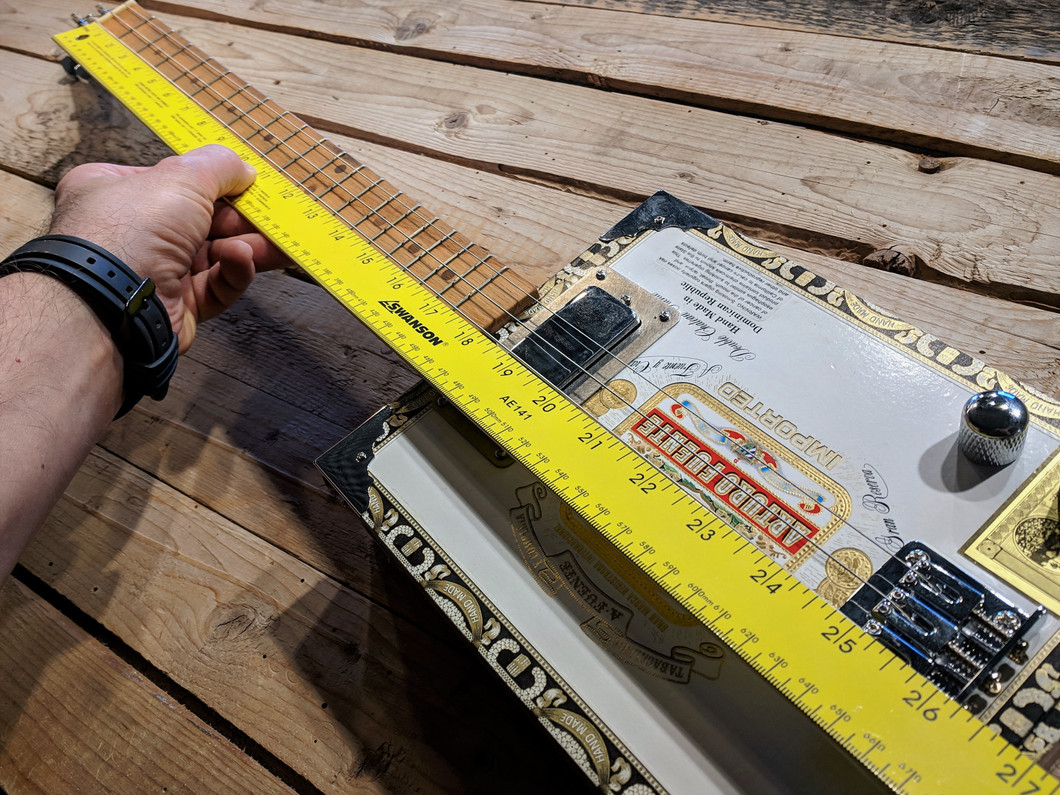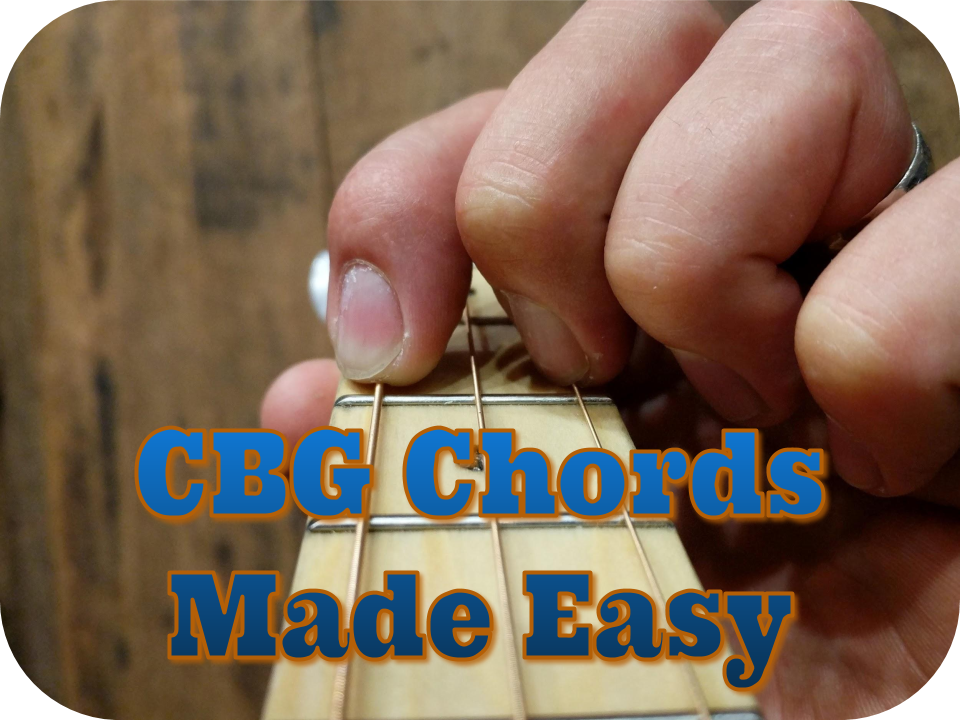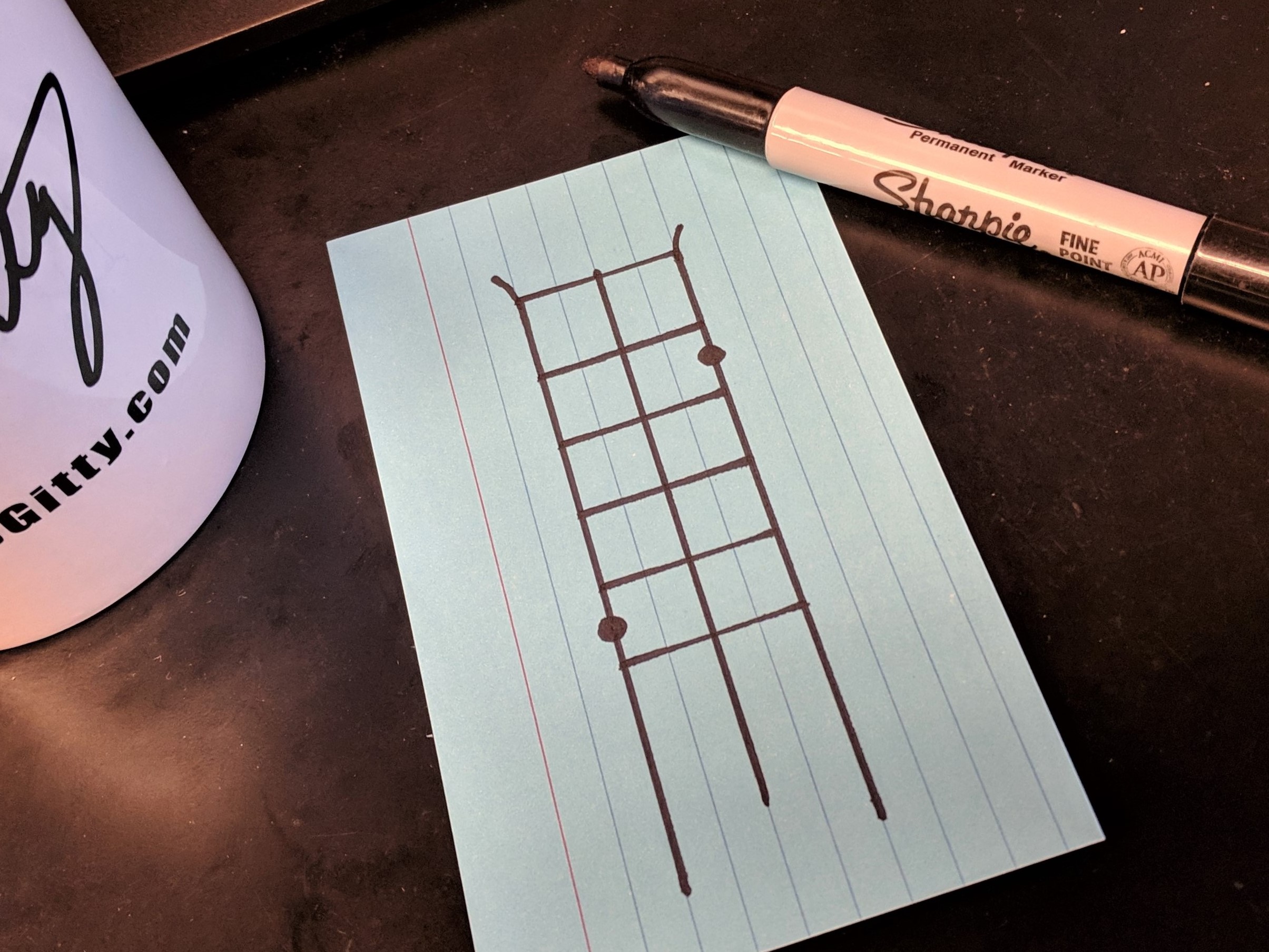What Is Scale Length & Why Does It Matter?
What is scale length and why should you care?
Given the “no rules” mantra in the cigar box guitar community, the term scale length looks an awful lot like a rule, doesn’t it?
And if there are no rules to building cigar box guitars – a big reason why they’re so much fun – then why do you need to learn about scale length?
Well, rather than bog you down with confusing terminology and the science of it all, what you’ll find here is the simple definition of scale length and the two big reasons why it should matter to you.
Reasons such as...
- How it affects your cigar box guitars sound
- How it affects your cigar box guitars feel
The rest we’ll leave to the physics majors, high-end luthiers, and those who have time to worry about such things.
Instead, this article gives you the knowledge necessary to dial-in your builds to sound and feel the way you want when played.
But first things first.
What is scale length?
Put simply, scale length is the distance between where the strings contact the nut and where they contact the bridge.
Some details affect that simple definition, but this gives you an overall picture of scale length.
But why should this matter to you?
How does scale length affect the sound and feel of your cigar box guitar?
Let’s find out.
How does scale length affect how my cigar box guitar sounds?
Tone
Let’s look at two cigar box guitars (CBGs) using the same gauge strings, both tuned G-D-G, but that have different scale lengths, say 25 (635mm) and 23-inches (584mm).
Strings on the 25-inch scale CBG are under higher tension (discussed later in this article) and will likely have rich, robust tones that ring loud and bright with a big low-end.
Whereas the strings on the 23-inch scale CBG are under less tension, and therefore have softer, thicker, and warmer tones.
This can be explained, in part, because of harmonics.
To better understand this, try the following exercise.
Use one hand to lightly touch a string on your CBG right over the 12th fret.
With the other hand pluck the string, then immediately lift your finger touching the string.
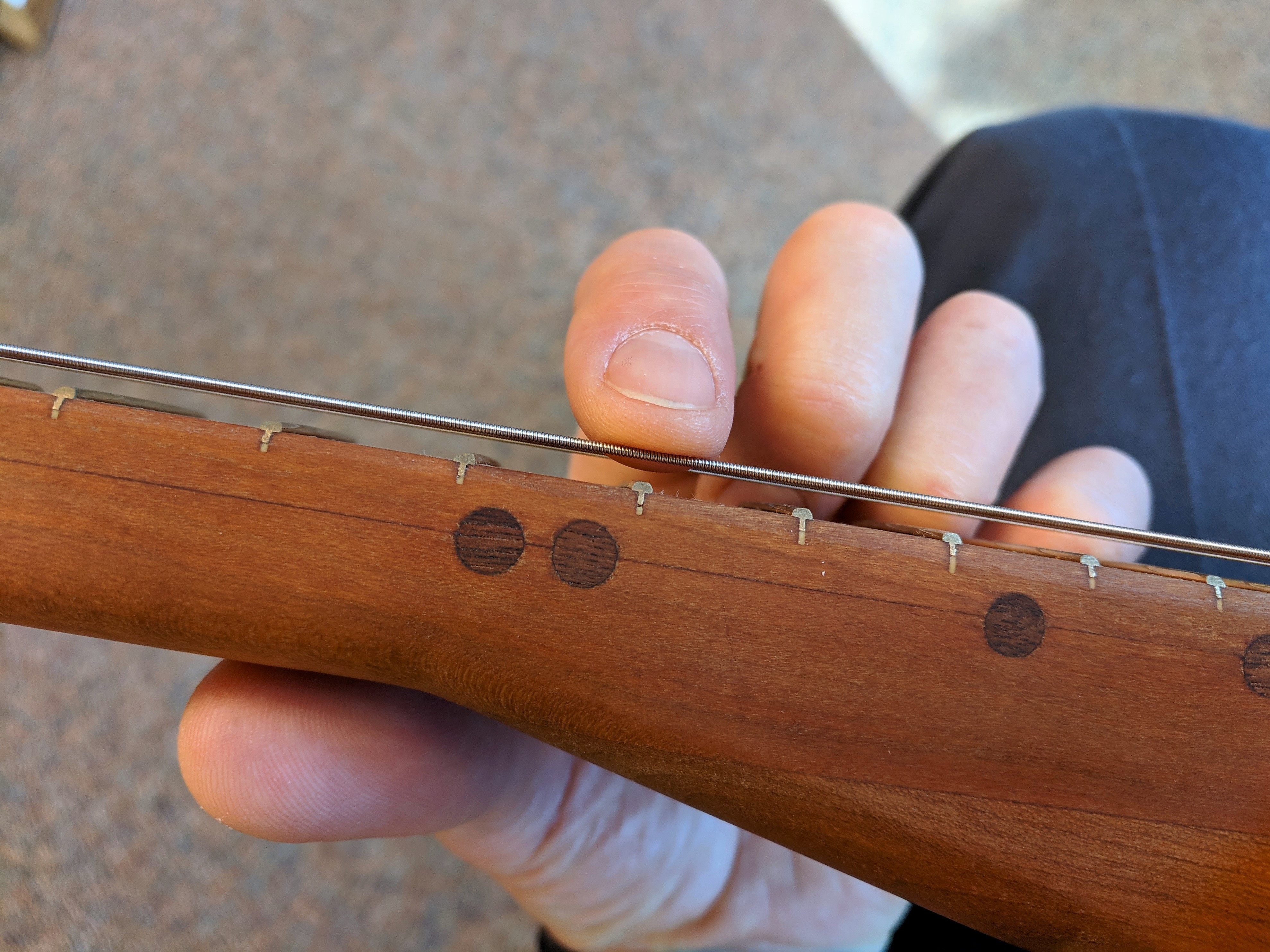
You’ll hear a note ring out that doesn’t require you to press the string down to the fret.
That note is a harmonic and, in this case, is an octave higher in pitch than the open string.
If you lightly touch the string up and down the fretboard and pluck it, you’ll hear harmonics of different pitches in other locations.
On a longer scale CBG, those harmonics are spaced further apart than a short scale CBG.
That spacing contributes to the loud chime of longer scale CBGs and the thicker sound of tightly packed harmonics on a short scale CBG.
But that’s not all. Scale length isn’t just about tone; it also affects your CBGs intonation.
Intonation
Intonation refers to your cigar box guitar sounding in tune all the way up the fretboard.
An easy way to determine this is, when your guitar is in-tune, to play all three strings open.
Then barre all three strings at the first fret and strum.
Continue to play all three strings, barring at the same fret, slowly making your way up the fretboard to the 12th.
As you go up the fretboard, if the strings sound progressively out-of-tune, the intonation may need to be adjusted.
One adjustment that can be made is called compensation.
Compensation
Explaining compensation and intonation here presumes action (a.k.a. string height, discussed later in this article) well-suited for fretted CBG play.
Look at your CBG neck from the side. Next, fret the lowest (thickest-gauge) string at the 12th fret.
When pressed to the fretboard, the string stretches.
That stretching can result in a note with a sharper pitch than intended.
This holds especially true for heavier-gauge strings.
To compensate for string-stretching, bridges are often set at an angle (as opposed to perpendicular to the strings) with a little more length added to the heavier than the lighter strings.
For that reason, you can see how scale length is a little more complicated than a single measurement.
Here’s a little scale length compensation test you can run on your CBG.
Play your lowest string open.
Next, play the same string pressing down at the twelfth fret.
The fretted note should be the same as the open note, only an octave higher in pitch.
However, if the fretted note sounds a little sharper (higher-pitched) than the open note, you can increase the string length to compensate for that stretch.
For a single bridge, such as a bolt or length of wood, simply set the bridge at an angle to increase the string length between the bridge and 12th fret.
To compensate for a hardtail bridge, increase the string length by adjusting the individual saddle for the tested string.
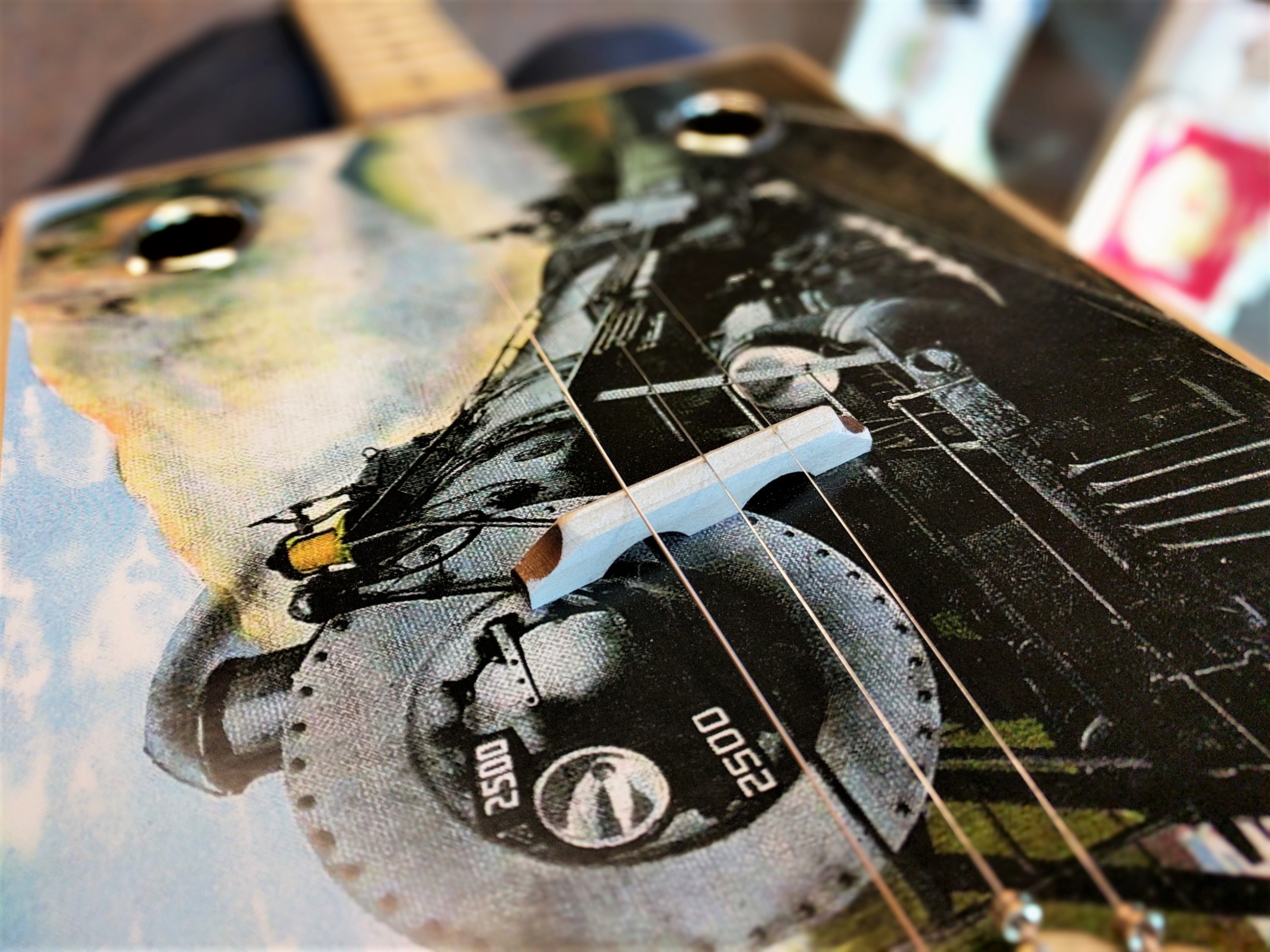
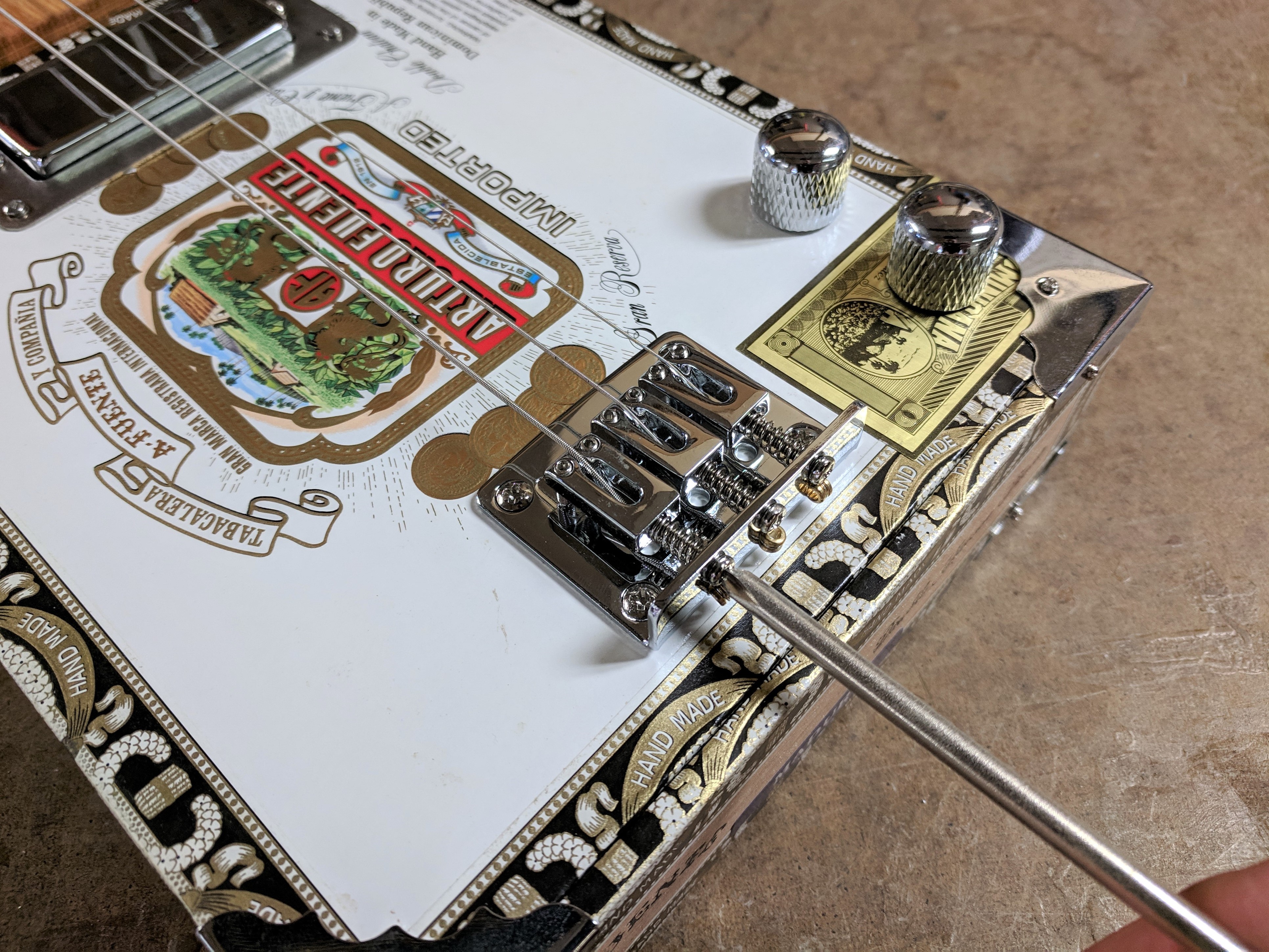
These are ways to compensate for strings stretching, by adjusting the intonation for the best sound in your CBGs scale length.
All the above is pretty easy to use to dial-in your CBGs sound.
But how about the CBGs playability? How does scale length affect the feel?
How does scale length affect how my cigar box guitar feels when played?
Fret Spacing
Fret spacing has an enormous effect on how a CBG feels, such as
- how easy or difficult it is to play chord shapes
- and how far your hand must travel between notes and chords
You see, the longer the scale length, the greater the distance between frets.
So, on a 25-inch (635mm) scale CBG, some foundational chord shapes, other than one-finger chords, may be difficult to finger, especially for smaller hands.
However, on a 23-inch (584mm) scale CBG, for example, since the frets are closer together, those same chord shapes become much more comfortable to finger.
Plus, the longer the scale, the more difficult it becomes to move from one chord to another, especially if you’re required to jump a few frets up or down to finger the shape.
This difficulty can even hold true for one-finger chords.
None of this is to dissuade you from building with any particular scale length.
Instead, it’s all just some practical insight to help you better understand the instruments you know and love.
In fact, this next bit of information may shed a favorable light on scale lengths you previously hadn’t considered.
Here are some essential resources to effectively build with specific scale lengths:
- Fretting Scale Length Template - 4 Scales Medium to Long (24"-25.5")
- Fretting Scale Length Template - 4 Medium-length Scales (20"-23")
- Fretting Scale Length Template - 4 Short-to-Medium-length Scales (16-19")
- Ukulele and Mandolin Fretting Scale Length Template - 4 Short-length Scales (13-15")
- 15pc. Acrylic Fretting Scale Template MEGA PACK - From 13-inch uke to 34-inch bass!
Tension
Tension, or string tension, is how tight the strings are strung and how it affects the overall instrument in terms of playability, or feel.
Just as before, the following examples use the same gauge strings tuned to the same notes, only on different scale length CBGs.
To fully understand string tension, it's helpful to know that longer scales have higher tension. This results in tighter strings for crisp strumming and rhythm play, and also aids in faster picking.
Shorter scales, on the other hand, have lower string tension, giving the CBG a more relaxed feel to perform string bends and vibrato, all while decreasing the chance of breaking a string.
Here's another way to look at string tension –
To tune your cigar box guitar to, say, G-D-G using the same gauge strings,
- Longer scale lengths require higher string tension
- Shorter scale lengths require lower string tension
String tension doesn't just affect how your CBG feels. It also has a direct effect on another important feature of CBGs built for fretted play.
Action
Action, or string height, is the distance between the strings and the frets.
And string tension plays a significant role in determining action.
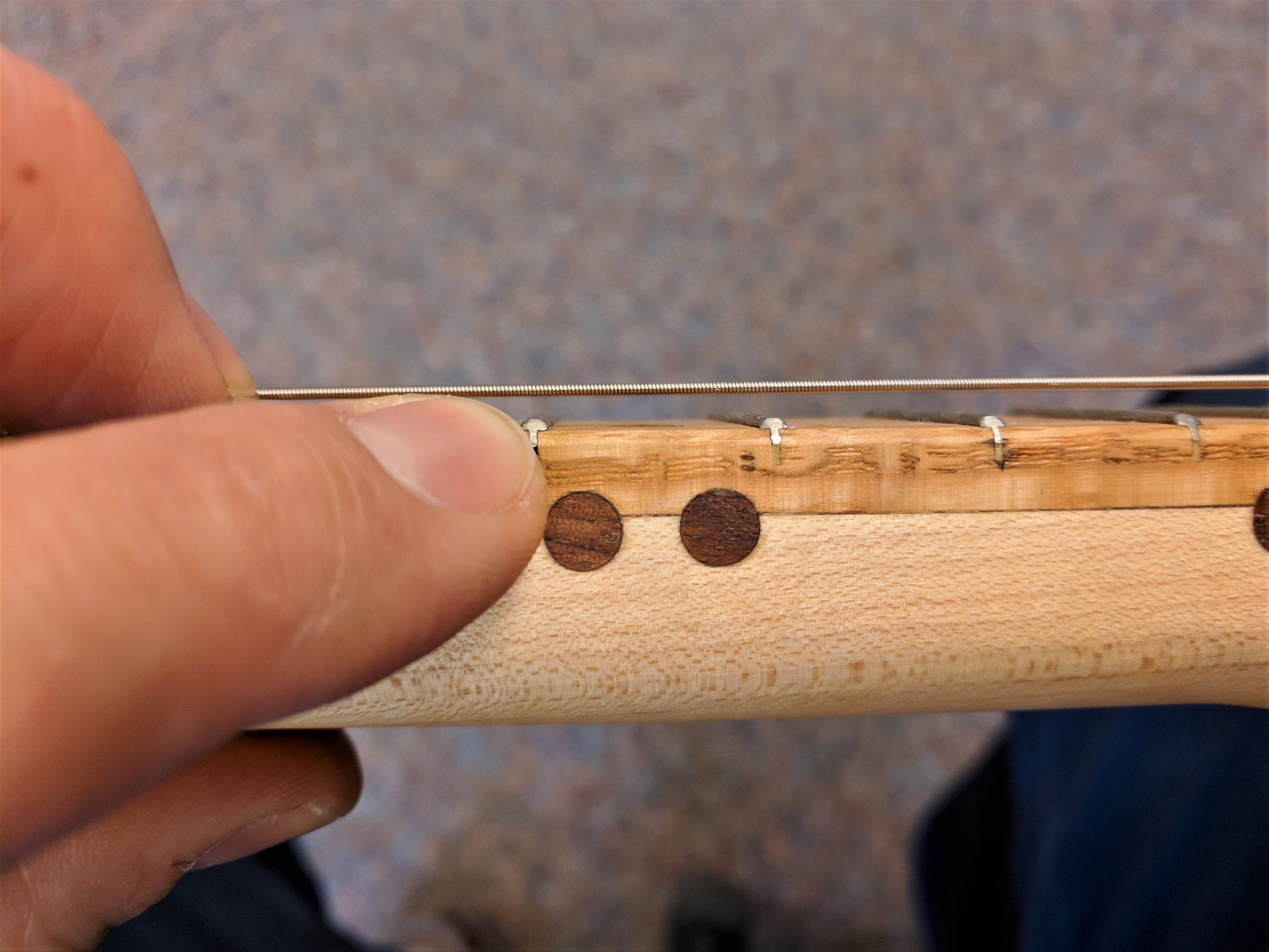
For a fretless CBG, or one intended solely for slide-play, the action is of little concern.
However, action for a fretted CBG can make or break not only how the guitar sounds but also how it feels.
As you now know, longer scale lengths, again say 25-inches, have higher string tension.
That higher tension results in tighter strings that don’t “flop around” as much as on a 23-inch scale CBG using the same string gauges.
So, given that your frets are level and your neck is straight, those tighter strings allow you to have low string action without fret buzz.
And as you’ve already learned, tight strings with low action make for clean, crisp chords that sound clear and loud.
On a shorter scale CBG, again say 23-inches, low tension strings have more slack.
Because of this, you need higher action for the strings to vibrate or you increase the chance of hearing fret buzz.
Now here’s a little secret that we’ll unpack more at a later date –
one way to get low action on a short scale cigar box guitar is to install heavier gauge strings.
But as mentioned, that’s a topic for another article.
So let’s review why scale length should matter to you.
To Review
Using two CBGs tuned the same, with the same string gauges, and that have different scale lengths –
The longer scale length has higher string tension and low action for loud, bright, crisp strumming and picking.
The shorter scale length has lower tension for warm, thick tones, as well as excellent feel and playability to more easily move between chords and notes.
As with so many things about cigar box guitars, there is no one “right way” to build a CBG.
In fact, the “no rules” cigar box guitar mantra is a welcome respite from a structured world with so many daily expectations of you.
However, a little knowledge is always good to keep in your back pocket, always in-the-ready to help you build your next CBG.
And with a greater understanding of scale length, your next CBG may be your best to date.
To build with the most accurate scale lengths, check out this ultimate fretting starter kit.
Must Reads...
Continue down the path of cigar box guitar mastery with the following must-read articles.
3-String Cigar Box Guitar Chord Forms Made Easy: The Ultimate Guide
Want to learn new chords for your 3-string cigar box guitar?
Interested in playing your cigar box guitar with more than just one finger?
In this article, you'll learn...
- How to play the most valuable chords on a cigar box guitar tuned G-D-G
- What a chord form is
- How to play a chord, so it sounds good
- How to read a chord chart
- How to play the most popular chord progression
- How to mirror, or flip chord forms
- Where to learn more chords to become a well-rounded player
Click here to gain access to the ultimate guide for 3-string cigar box guitar chord forms.
Set Aside 20 Minutes Each Day To Do This
Want to learn how to play chords on your 3-string cigar box guitar? Use flashcards 20 minutes a day.
That’s right. Those things you used to learn your multiplication tables and other grade school lessons.
As you're about to see, they're not just for kiddos.
With a handful of flashcards and a short amount of time devoted each day to use them, you can master 3-string cigar box guitar chords.
Keep reading to learn how this trick will help you master 3-string cigar box guitar chord forms.
Recent Posts
-
2024 World's Wildest Electric Cigar Box Guitar Build-Off Winners!!!
C. B. Gitty Crafter Supply is proud to announce the winners of the 2024 "World's Wildest Electric Ci …31st Oct 2024 -
Improved C. B. Gitty: Easier Than Ever! (Work in Progress)
Ben “Gitty” has been cleaning house, making our website even easier find your favorite parts, kits a …7th Oct 2024 -
Build-Off Contest 2024: The World's Wildest ELECTRIC Cigar Box Guitar
CBGitty.com is looking for the WILDEST, LOUDEST & MOST DIABOLICAL electric cigar box guitar ever …6th Sep 2024

